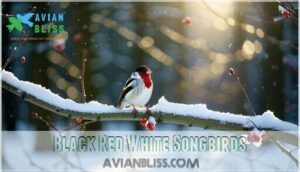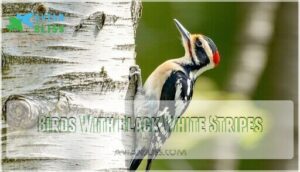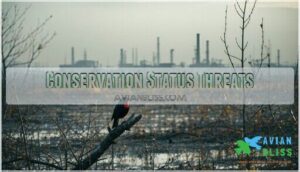This site is supported by our readers. We may earn a commission, at no cost to you, if you purchase through links.

Woodpeckers like the Red-headed and Pileated steal the show with their bold color combinations. Songbirds such as the Rose-breasted Grosbeak rock similar stunning palettes that make them stand out in forests and backyards.
These vibrant colors aren’t just for show – they’re key signals of bird health and attractiveness to potential mates.
Whether you’re spotting a Scarlet Tanager or a striped Hairy Woodpecker, these tri-colored feathered friends are living proof that Mother Nature’s design is anything but boring.
Ready to become a backyard bird-watching pro?
Table Of Contents
- Key Takeaways
- Black Red White Birds Overview
- Woodpeckers With Red Heads
- Black Red White Songbirds
- Birds With Black White Stripes
- Conservation Status Threats
- Frequently Asked Questions (FAQs)
- What bird has a Red Wing?
- What birds are red and black?
- What is a black and white bird with a red head?
- What is a red winged blackbird?
- How many black and white birds have a red head?
- What are black and white birds?
- What bird has a red chest?
- What bird has a red head?
- What kind of bird is red, black, and white?
- How rare is a Rose-breasted Grosbeak?
- Conclusion
Key Takeaways
- You’ll discover that black, red, and white birds aren’t just visually stunning, but they’re also critical indicators of ecosystem health and mate attraction strategies in nature.
- Birds like woodpeckers and songbirds use their vibrant color combinations as sophisticated communication tools, helping them defend territories, attract mates, and signal their fitness to potential partners.
- Many of these colorful species face serious conservation challenges, with habitat loss, climate change, and human activities threatening their populations, meaning your personal conservation efforts can make a real difference in protecting these remarkable birds.
- From the Rose-breasted Grosbeak to the Red-headed Woodpecker, these birds showcase nature’s incredible design, demonstrating how color and pattern serve multiple survival purposes beyond simple aesthetic appeal.
Black Red White Birds Overview
You’ll be amazed by the stunning palette of black, red, and white birds that paint North America’s skies with their vibrant plumage.
From woodpeckers with striking red crests to songbirds sporting bold color combinations, these feathered artists showcase nature’s most dramatic color blocking.
Woodpeckers With Black Red White Colors
Several stunning woodpeckers showcase nature’s black, red, and white palette.
From the red-bellied woodpecker‘s vibrant crown to the red-headed woodpecker’s striking patterns, these forest drummers are master surveyors of tree bark. They excavate nests, communicate through rhythmic drumming, and hunt insects with surgical precision.
Regional variations reveal unique adaptations in their acorn storage and nest-building techniques, making each species a fascinating ecological marvel.
Songbirds With Black Red White Plumage
After exploring woodpeckers’ vibrant plumage, let’s zoom in on songbirds that rock nature’s boldest color palette.
These feathered artists showcase stunning black, red, and white combinations that’ll make you do a double-take.
The Rose-breasted Grosbeak steals the show with its crimson chest and jet-black back, while Painted Redstarts add fiery drama to forest canopies.
Their unique vocalizations and regional distribution highlight how these songbirds use their eye-catching plumage variations to communicate, attract mates, and survive in competitive ecosystems.
Some species, like the Tricolored Blackbirds, feature striking red shoulder patches.
Birds of Prey With Black Red White Colors
The allure of raptors in black, red, and white plumage captivates bird enthusiasts and nature lovers alike.
Here are five stunning birds of prey that showcase this mesmerizing color palette:
- Red-tailed Hawk: Masters of the sky with striking red-tinged tails
- American Kestrel: Compact falcon with vibrant color variations
- Swainson’s Hawk: Uniquely marked with dramatic red chest
- Black-shouldered Kite: Sharp silhouettes against open landscapes
- Peregrine Falcon: Legendary hunters with breathtaking migration patterns
Woodpeckers With Red Heads
You’ll be fascinated by the vibrant world of woodpeckers with their striking red heads, a colorful demonstration to nature’s artistic design.
These remarkable birds, like the Red-headed and Red-bellied Woodpeckers, showcase a stunning palette of black, red, and white feathers that’ll make you stop and marvel at their unique beauty.
Red-headed Woodpecker
Picture a black and white feathered artist with a crimson crown – that’s the Red-headed Woodpecker!
These North American woodpeckers are struggling with habitat loss, their population plummeting by over 90%.
Their distinctive red head makes bird identification a breeze.
Masters of survival, they drill precise holes in deciduous and coniferous forests, caching food and creating intricate nests.
Their diet includes insects, berries, and nuts, showcasing their adaptability in changing landscapes across their native range.
Red-bellied Woodpecker
After the Red-headed Woodpecker’s striking appearance, the Red-bellied Woodpecker takes the stage with its own woodland drama.
This black-and-white "zebra-backed" bird sports a vibrant red crown that’ll catch your eye in shady forests and backyard havens. Its range expansion tells a tale of adaptability across diverse landscapes.
- Masters of food caching
- Expert nest excavators
- Woodland ecosystem architects
- Skillful insect hunters
- Backyard bird watching favorites
With a rufous belly hint and remarkable bird identification markers, these woodpeckers turn every forest edge into their personal hunting ground.
Pileated Woodpecker
After mastering the Red-bellied Woodpecker’s traits, you’ll be stunned by the Pileated Woodpecker’s forest dominance.
These crow-sized woodpeckers reign supreme in woodland ecosystems, wielding powerful beaks that carve distinctive oval holes.
With a signature red crest and black-and-white plumage, they’re masters of foraging behavior, hunting carpenter ants deep within tree trunks. Their loud, distinctive calls announce their presence, making them an iconic symbol of North American bird identification.
Their ecological role transforms forests, creating habitats for countless other species. Pileated Woodpecker’s
Hairy Woodpecker
Amid North American woodlands, the Hairy Woodpecker stands out with its distinctive black-and-white plumage and occasional red cap.
These skilled hunters navigate tree bark with precision, seeking out hidden insect meals.
Here’s what makes them unique:
- Larger than Downy Woodpeckers, with a proportionally longer bill
- Masters of bark-drilling techniques in mature forests
- Adaptable foragers consuming beetles, ants, and wood-boring larvae
Their habitat preferences span deciduous and coniferous woodlands, making them a versatile species in the woodpecker family.
Black Red White Songbirds
When you explore the vibrant world of black, red, and white songbirds, you’ll discover a stunning palette of nature’s most striking feathered performers.
You’ll be amazed by the Rose-breasted Grosbeak, Painted Redstart, and other colorful species that turn forest landscapes into living canvases of bold contrast and eye-catching beauty.
Rose-breasted Grosbeak
The Rose-breasted Grosbeak dazzles birdwatchers with its eye-catching plumage and remarkable adaptability.
Male grosbeaks sport a bold scarlet chest against jet-black shoulders, while females rock sophisticated streaked brown feathers.
These migratory champions feast on a diverse conifer seed diet, hopping between North American summers and Central American winters.
Their distinctive song echoes through forest canopies, signaling territorial boundaries and attracting mates.
Nesting high in trees, these red birds master the art of survival with strategic breeding habits that guarantee.
Painted Redstart
A mountain-hopping songbird, the Painted Redstart dazzles birdwatchers with its striking plumage.
A dazzling mountain dancer, the Painted Redstart leaps through oak-pine canyons, nature’s living art in motion.
This warbler commands attention through its unique hunting strategy:
- Flash wings to startle hidden insects
- Hover and glean forest branches
- Dart swiftly through oak-pine habitats
Thriving in southwestern canyons from Arizona to Nicaragua, it’s a master of survival.
They’re often found in riparian woodland habitats.
Its glossy black feathers, white wing patches, and crimson belly make it a standout in bird identification, showcasing nature’s most stunning color palette.
Tricolored Blackbird
Nesting in massive colonies, the Tricolored Blackbird stands out among black birds with its striking red shoulder patch and bold white streak.
Critically endangered, these social birds face severe habitat loss challenges.
Their unique plumage and remarkable breeding behavior make them a conservation priority across California’s landscapes.
| Characteristic | Description |
|---|---|
| Population |
Red-breasted Chat
After exploring the diverse Tricolored Blackbird, let’s zoom in on another striking species: the Red-breasted Chat.
With its jet-black head and scarlet breast, this Central American habitat dweller captivates bird watchers.
Males showcase bold plumage variations, while females sport subtler colors.
Their vocalizations echo through lowland forests, and their diet reflects their adaptable nature.
Despite their beauty, Conservation Needs for this unique bird species remain a critical concern for bird identification enthusiasts.
Birds With Black White Stripes
You’ll be amazed by the stunning black and white striped birds that nature has crafted with remarkable precision.
From woodpeckers to songbirds, these feathered marvels showcase intricate stripe patterns that’ll make you stop and stare in wonder.
Woodpeckers With Black White Striped Wings
If you’ve been captivated by songbirds, wait until you meet woodpeckers with their jaw-dropping black and white striped wings!
These masters of camouflage sport Wing Stripe Variation that serves evolutionary purposes.
Each species brings unique flair to forest landscapes:
- Unparalleled Adaptability: Blending seamlessly with tree bark
- Incredible Foraging Skills: Hunting insects with precision
- Stunning Visual Complexity: Nature’s living artwork
- Survival Genius: Stripe Camouflage as a defensive strategy
These woodpeckers—like the red-headed and hairy varieties—turn every flight into a breathtaking display.
The similar Downy and Hairy Woodpeckers show how plumage patterns can vary.
Birds With Black White Plumage
In a space with black and white plumage, nature’s canvas reveals stunning monochromatic masterpieces. From seabirds to songbirds, these feathered artists showcase remarkable diversity.
| Bird Species | Plumage Pattern | Habitat |
|---|---|---|
| Razorbills | Sleek black/white | Coastal cliffs |
| Black-billed Magpies | Iridescent black/white | Open woodlands |
| Common Loons | Intricate striped | Northern lakes |
| Pied Avocets | White body/black wings | Wetlands |
| Black-and-White Warblers | Striped pattern | Forest edges |
These birds prove simplicity can be breathtakingly beautiful.
Birds With Red Rumps
If black and white birds piqued your interest, get ready for nature’s colorful rumps!
Red-splashed tail feathers tell a wild story of 1) display behavior, 2) species variation, 3) habitat adaptation, and 4) evolutionary advantage.
Birdwatchers, spot these vibrant patches on Killdeer, White-rumped Sandpiper, and Ruddy Turnstone—each rump coloration a unique signature in the avian world.
Conservation Status Threats
Regarding black, red, and white birds, you’ll find that many species face serious conservation challenges due to habitat loss, climate change, and human activities.
These stunning creatures need your help to survive, so understanding their threats and taking action can make a real difference in protecting their populations and preserving their unique ecosystems.
Threats to Populations
Because human activities are decimating bird populations, your awareness matters.
Every bird saved is a symphony preserved in nature’s grand concert.
Habitat loss, climate change, and invasive species threaten endangered species like red-headed woodpeckers.
Pesticide use, urban sprawl, and deforestation fragment critical bird habitats.
Conservation demands urgent action—protecting these vibrant creatures requires understanding their fragile ecosystems and supporting bird preservation efforts.
Habitat Preservation Efforts
Because healthy ecosystems depend on strategic conservation, you can transform local landscapes into thriving bird sanctuaries.
Plant native greenery, minimize pesticide use, and create bird-friendly spaces that support Forest Management and Wetland Restoration.
Install window decals to prevent collisions, keep cats indoors, and design wildlife-friendly yards.
By participating in Reforestation Projects and Protected Areas initiatives, you’ll directly contribute to bird habitats preservation.
Community Involvement is key—every small action helps protect these stunning black, red, and white feathered friends.
Conservation Initiatives
In the area of bird conservation, protecting our feathered friends takes strategic, collaborative efforts. Conservation initiatives are critical for maintaining ecological balance and preserving biodiversity.
Here’s how experts are making a difference:
- Habitat Restoration: Rebuilding critical ecosystems for bird populations
- Population Monitoring: Tracking endangered bird species‘ numbers
- Anti-Poaching Measures: Protecting vulnerable bird habitats
- Community Engagement: Involving local communities in conservation
- Climate Change Adaptation: Developing strategies for bird species survival
Organizations like the North American Bird Conservation Initiative and American Bird Conservancy lead these important bird conservation efforts, ensuring our winged companions continue to thrive in changing environments.
Understanding the IUCN Red List is key for identifying species at risk.
Ways to Support Conservation
Want to make a real difference for our feathered friends?
Become a bird conservation hero by joining local Habitat Restoration projects!
Check out these actionable ways to protect bird populations:
| Action | Impact |
|---|---|
| Citizen Science | Track bird populations |
| Reduce Pesticides | Protect bird habitats |
| Support Organizations | Fund conservation efforts |
| Bird-Friendly Practices | Create safe local environments |
Your small steps can save entire ecosystems!
Consider donations aid conservation efforts.
Frequently Asked Questions (FAQs)
What bird has a Red Wing?
Picture a winged canvas painting the sky!
You’ll find the Red-winged Blackbird sporting a bold crimson shoulder patch against its jet-black plumage.
It’s a striking bird that’ll catch your eye in wetlands, marshes, and grasslands across North America.
What birds are red and black?
You’ll find red and black birds like the Rose-breasted Grosbeak, Painted Redstart, and Red-winged Blackbird.
These vibrant species showcase nature’s bold color palette across woodlands, forests, and open landscapes throughout North America.
What is a black and white bird with a red head?
Nature’s palette paints a striking woodpecker—the Red-headed Woodpecker.
You’ll spot its jet-black back, snow-white chest, and fiery crimson head.
Inhabiting forests across North America, this bird turns heads with its bold, distinctive coloration.
What is a red winged blackbird?
You’ll spot a red-winged blackbird by its jet-black body and vibrant red shoulder patches.
These striking males defend territories near marshes, singing loudly to attract mates and warn off rivals during breeding season.
How many black and white birds have a red head?
You’ll discover six black and white birds sporting red heads: Red-headed Woodpecker, Red-Capped Cardinal, Red-Crested Cardinal, Acorn Woodpecker, Red-naped Sapsucker, and the Red-bellied Woodpecker.
Each unique in its woodland habitat.
What are black and white birds?
Black and white birds are a striking canvas of nature’s artistry.
You’ll encounter woodpeckers, magpies, and penguins showcasing dramatic monochrome plumage.
These feathered friends range from forest dwellers to arctic survivors, each with unique patterns and behaviors. Complete concepts
What bird has a red chest?
You’ll find the Rose-breasted Grosbeak sporting a striking scarlet red chest, contrasting boldly with its black hood and white belly.
Adult males showcase this vibrant plumage during breeding season, making them a stunning sight.
What bird has a red head?
You might think red heads are rare, but several birds sport this vibrant look.
The Red-crested Cardinal, Red-headed Woodpecker, and Red-Capped Cardinal will dazzle you with their striking crimson crowns.
These birds live in diverse habitats across North and South America.
What kind of bird is red, black, and white?
You’ll love the Rose-breasted Grosbeak, a striking woodpecker with scarlet chest, black head, and white belly.
This migratory bird dazzles in North American forests, showing off its bold, eye-catching plumage during summer breeding season.
How rare is a Rose-breasted Grosbeak?
Like a hidden treasure in nature’s palette, the Rose-breasted Grosbeak isn’t rare but isn’t common either.
You’ll spot them during summer migrations across North America, their vibrant plumage a fleeting, beautiful sight in woodland landscapes.
Conclusion
Picture Emily’s backyard, where a Rose-breasted Grosbeak catches her eye—its black, red, and white plumage a living demonstration to nature’s artistry.
When you explore black, red, and white birds, you’re exploring more than colors; you’re witnessing survival strategies, mating displays, and ecological adaptations.
These feathered wonders aren’t just beautiful—they’re complex, resilient creatures signaling the intricate balance of our natural world.
Your newfound appreciation can spark conservation efforts and protect these remarkable avian gems.







